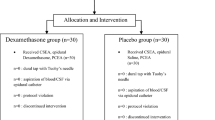Abstract
Purpose
Labor pain is one of the most agonizing pains experienced by all delivered women. Many pharmacological agents used in labor analgesia require intense monitoring facilities, which are not available in routine obstetric practice in low-resource settings. This study aimed to compare the efficacy of intravenous (IV) paracetamol and intramuscular (IM) tramadol on labor pain relief, labor progression, and maternal and neonatal outcomes.
Methods
This randomized drug trial was carried out on 110 women divided into two groups. Group A women received 1000 mg of IV paracetamol, and Group B women received 100 mg of IM tramadol during the active phase of labor. Pain intensity was assessed by the Visual Analogue Scale (VAS) at intervals till 120 min of delivery. The maternal and neonatal outcomes were recorded.
Results
There was a statistically significant fall in pain score till 180 min of drug administration in the paracetamol group and 120 min in the tramadol group. At 180 min and 240 min, paracetamol is more effective than tramadol (p value 0.004 at 180 min and 0.0119 at 240 min). There were significantly low pain score levels at 60 min of delivery in the paracetamol group (p value—0.004). Nausea and vomiting were significantly higher in the tramadol group (p value 0.000013).
Conclusion
Compared to IM tramadol, IV paracetamol has a longer duration of action and fewer maternal side effects, making it suitable for parenteral analgesia in labor. Due to a better safety profile, there is no need for intense maternal and fetal monitoring with IV paracetamol.
Trial registration
Clinical Trials Registry—India (CTRI registration number—CTRI /2019/05/019244).


Similar content being viewed by others
References
Abdollahi MH, Mojibian M, Pishgahi A, Mallah F, Dareshiri S, Mohammadi S et al (2014) Intravenous paracetamol versus intramuscular pethidine in relief of labour pain in primigravid women. Niger Med J 55(1):54–57
Pita CP, Pazmiño S, Vallejo M et al (2012) Inhaled intrapartum analgesia using a 50–50 % mixture of nitrous oxide–oxygen in a low-income hospital setting. Arch Gynecol Obstet 286:627–631. https://doi.org/10.1007/s00404-012-2359-6
Aimakhu CO, Saanu OO, Olayemi O (2017) Pain relief in labour: a randomized controlled trial comparing intramuscular tramadol with intramuscular paracetamol at the university college hospital, Ibadan Nigeria. Trop J Obstet Gynaecol 34(2):91–98
Das BP, Ali J, Baruah A (2016) Comparative study between intravenous paracetamol and intramuscular tramadol as labour analgesic. Int J Sci Res 5(10):1675–1679
Leppink J, O’Sullivan P, Winston K (2017) Are differences between groups different at different occasions? Perspect Med Educ 6:413–417. https://doi.org/10.1007/s40037-017-0380-y
Makkar KJ, Jain K, Bhatia N, Jain V, Mal Mithrawal S (2015) Comparison of analgesic efficacy of paracetamol and tramadol for pain relief in active labour. J Clin Anesth 27(2):159–163
Lallar M, Anam HU, Nandal R, Singh SP, Katyal S (2015) Intravenous paracetamol infusion versus intramuscular tramadol as an intrapartum labor analgesic. J Obstet Gynaecol India 65(1):17–22. https://doi.org/10.1007/s13224-014-0556-x
Elbohoty AE, Abd-Elrazek H, Abd-El-Gawad M et al (2012) Intravenous infusion of paracetamol versus intravenous pethidine as an intrapartum analgesic in the first stage of labour. Int J Gynaecol Obstet 118(1):7–10
Viegas OA, Khaw B, Ratnam SS (1993) Tramadol in labour pain in primiparous patients A prospective comparative clinical trial. Eur J Obstet Gynecol Reprod Biol 49(3):131–135
Kashif S, Hamid M (2016) Efficacy of intravenous paracetamol on pressor response in patients undergoing cesarean section under general anesthesia. J Anesthesiol Clin Pharmacol 32(2):210–213
Jain S, Arya VK, Gopalan S, Jain V (2003) Analgesic efficacy of intramuscular opioids versus epidural analgesic in labour. Int J Gynecol Obstet 83(1):19–27
Kuti O, Faponle AF, Adevemi AB, Owolabi AT (2008) Pain relief in labour: a randomized controlled trial comparing pentazocine with Tramadol. Nep J Obstet Gynaecol 3:14–18
Pandya ST (2010) Labour analgesia: recent advances. Indian J Anaesth 54(5):400–408
Kellow SY, Ali SMM (2012) Effect of pethidine versus tramadol on labour pain in primiparous women. JSMC 2:17–22
Headley J, Northstone K, Simmons H, Golding J, ALSPAC Study Team (2004) Medication use during pregnancy: data from the avon longitudinal study of parents and children. Eur J Clin Pharmacol 60(5):355–361
Werler MM, Mitchell AA, Hernandez-Diaz S, Honein MA (2005) Use of over-the-counter medications during pregnancy. Am J Obstet Gynecol 193:771–777
Gupta K, Mitra S, Kazal S, Saroa R, Ahuja V, Goel P (2016) IV paracetamol as an adjunct to patient-controlled epidural analgesia with levobupivacaine and fentanyl in labour: a randomized controlled study. BJA 117(5):617–622. https://doi.org/10.1093/bja/aew311
Acknowledgements
We would like to thank all the participants of the trial. We would also like to extend our thanks to statisticians from the community medicine department, who performed computer-generated random sequence allocation, and maternity assistants, staff nurses, and registrars on duty in the labor room who helped in collecting study outcomes.
Funding
The authors have not disclosed any funding.
Author information
Authors and Affiliations
Contributions
MN: project development, recruitment of participants, data collection, and manuscript writing. GKP: project development, manuscript writing, and manuscript editing.
Corresponding author
Ethics declarations
Conflict of interest
The authors have no relevant financial or non-financial interests to disclose.
Ethical approval and clinical trials registry
This study was performed in line with the principles of the Declaration of Helsinki. Approval was granted by our Institute Ethics Committee (SMVMCH-ECO/AL/135/2018) and registered with Clinical Trials Registry—India (CTRI registration number— CTRI /2019/05/019244).
Publication consent
The authors affirm that publication consent has been received from all the participants.
Data citation
G K Poomalar (2022), “Comparison of intravenous paracetamol infusion versus intramuscular tramadol as labor analgesia—a randomised control trial”, Mendeley Data, V1, https://doi.org/10.17632/2gngzpwfbm.1.
Additional information
Publisher's Note
Springer Nature remains neutral with regard to jurisdictional claims in published maps and institutional affiliations.
Rights and permissions
About this article
Cite this article
Monisha, N., Poomalar, G.K. Comparison of intravenous paracetamol infusion versus intramuscular tramadol as labor analgesia: a randomized control trial. Arch Gynecol Obstet 307, 755–762 (2023). https://doi.org/10.1007/s00404-022-06585-2
Received:
Accepted:
Published:
Issue Date:
DOI: https://doi.org/10.1007/s00404-022-06585-2




